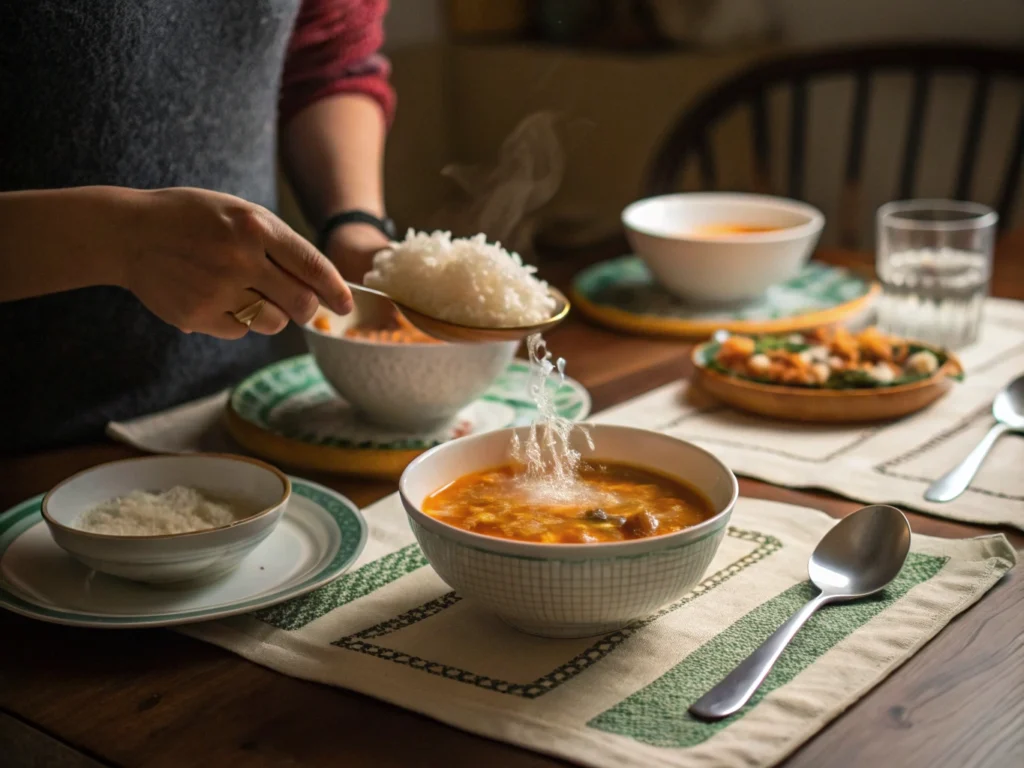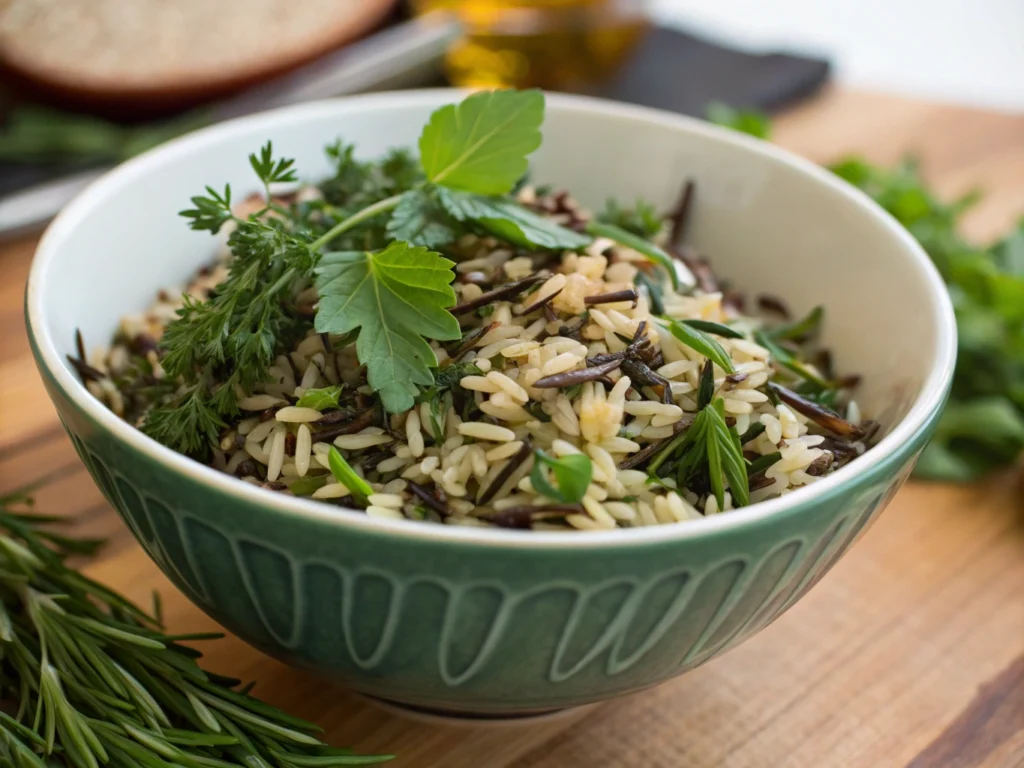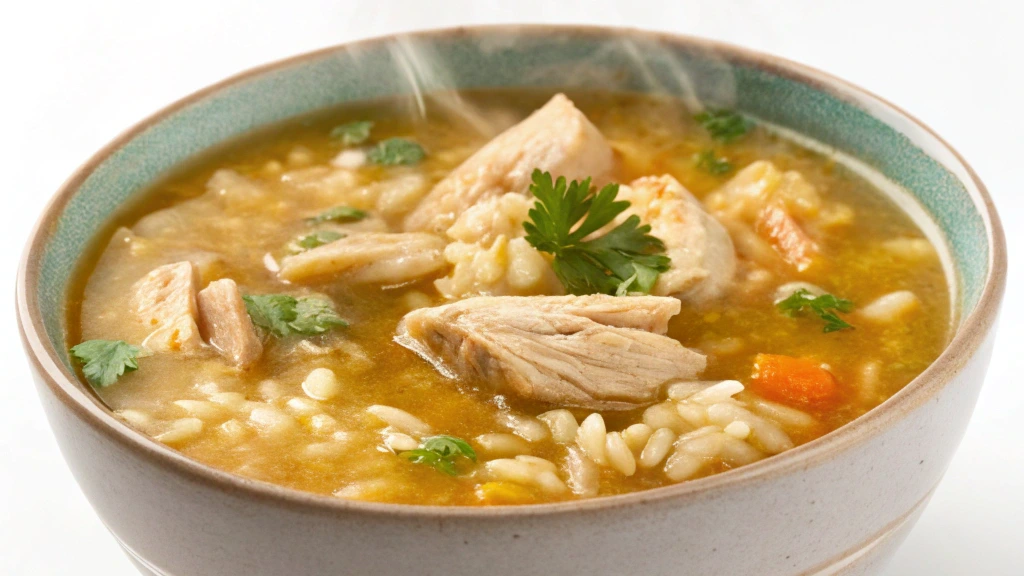Rice in soup sounds comforting, doesn’t it? But for many home cooks, it quickly turns into a soggy disaster. The challenge lies in managing rice’s natural absorbency. This article unpacks why rice gets soggy in soup, which types work best, and the simple techniques that guarantee success. By the end, you’ll know exactly how to add rice to soup without it becoming a mushy mess.
Understanding the Problem of Soggy Rice in Soup
Why Does Rice Get Soggy in Soup?
Rice is a sponge in disguise. Once it hits liquid, it begins soaking up the broth like there’s no tomorrow. The starch in rice plays a significant role—it thickens the soup but also contributes to that sticky, overcooked texture. Cooking rice for too long in broth can result in grains that practically dissolve into a slurry.
The Science Behind Rice Absorbing Liquid
Rice’s absorbency isn’t just a culinary quirk; it’s science. The grains have a high concentration of amylopectin, a starch that releases when heated. This process not only changes the texture of the rice but can also drastically thicken your soup. That’s why understanding the right timing and preparation methods is crucial.
Common Mistakes When Adding Rice to Soup
Ever dumped uncooked rice straight into a bubbling pot of soup? You’re not alone. Some common blunders include:
- Adding too much rice: It absorbs liquid and expands, leaving you with a stew instead of a soup.
- Overcooking rice in soup: Long cook times result in mushy grains.
- Using the wrong type of rice: Short-grain varieties, for example, are notorious for turning gloopy.
Fixing these mistakes starts with selecting the right rice and using tried-and-true techniques for cooking it.
Types of Rice and Their Impact on Soup
Best Rice Types for Soup
Not all rice is created equal when it comes to soup. If you’re wondering, “How do you add rice to soup without getting soggy?”, the secret often lies in choosing the right variety. Long-grain rice, like jasmine or basmati, works wonders because it holds its shape well and doesn’t release excessive starch. Wild rice is another excellent choice, offering a chewy texture that complements brothy soups beautifully.
Conversely, medium- or short-grain rice tends to absorb more liquid, making it prone to becoming overly soft. These varieties are best reserved for creamy dishes like risottos.
Avoiding Short-Grain Rice in Soup
Short-grain rice, such as Arborio or sushi rice, is highly absorbent and loaded with starch. When added to soup, it thickens the broth excessively and creates a porridge-like texture. This might be ideal for some recipes, but it’s not the goal when you want a balanced soup with distinct grains of rice.
Instead, stick to firm, long-grain options to maintain the soup’s delicate texture and consistency.
Specialty Rices and Their Unique Benefits
Specialty rices, such as black rice or red rice, are less common but worth exploring. These grains bring unique flavors, vibrant colors, and firm textures to your soup. They are particularly good for adding visual appeal to broths or light soups where presentation matters.
Techniques for Cooking Rice Separately

Parboiling Rice for Better Texture
Cooking rice separately before adding it to soup is a game-changer. Parboiling—partially cooking rice in water—helps maintain the grain’s firmness. By stopping the cooking process halfway, you ensure the rice doesn’t soak up too much broth later.
After parboiling, rinse the rice under cold water to halt further cooking. This step also removes excess starch, preventing your soup from becoming overly thick.
Storing Cooked Rice for Soup
If you’re making soup in advance or planning for leftovers, always store the rice and soup separately. Combining them in storage leads to bloated, soggy grains. Instead, keep cooked rice in an airtight container and mix it into the soup just before serving.
Incorporating Rice Just Before Serving
The golden rule for adding rice to soup is timing. Cook your rice until it’s just shy of done, then ladle it into the soup right before serving. This keeps the rice firm while ensuring it absorbs just enough flavor from the broth.
For an even fresher approach, serve the soup and rice separately, allowing diners to combine them to their taste. This method works particularly well for soups with bold broths, like chicken or miso-based soups.
Adding Rice Directly to Soup: Tips for Success
Adjusting Liquid Ratios
When adding rice directly to soup, keeping the liquid-to-rice ratio in check is key. Rice naturally absorbs liquid as it cooks, which can quickly turn your soup into a stew. For every 1/2 cup of rice, ensure you have at least 8 cups of broth to maintain the soup’s consistency.
If you’re asking, “How do you add rice to soup without getting soggy?”, this step is crucial. Adjusting the liquid before adding rice ensures the grains stay firm without thickening the broth excessively.
Using Less Rice to Avoid Overabsorption
Another common mistake is overloading your soup with rice. A little goes a long way. Adding less rice not only prevents sogginess but also allows the broth’s flavor to shine. Think of the rice as a complement, not the star, in your soup recipe.
Timing Rice Addition During Cooking
Timing is everything when it comes to rice. Add it during the last 10–15 minutes of cooking to avoid over-softening. Keep a close eye as it simmers, tasting occasionally to ensure the rice is cooked to perfection without losing its bite.
Flavor Considerations When Adding Rice
Infusing Flavor into Rice Before Adding It to Soup
One overlooked tip is seasoning the rice before incorporating it into soup. Cook your rice in flavored broth or add aromatic spices like garlic, bay leaves, or saffron during the cooking process. This trick not only enhances the flavor of the rice but also elevates the overall taste of the soup.
Balancing Seasonings for Rice and Broth
When adding seasoned rice to soup, remember to adjust the broth’s seasonings to avoid overpowering flavors. For instance, a bold chicken broth pairs beautifully with lightly seasoned jasmine rice. Conversely, if the rice is heavily spiced, opt for a mild broth to create harmony in each spoonful.
For more inspiration on incorporating rice into soups, check out Spicy Chicken Soup with Rice. It’s packed with flavor and showcases how rice can enhance a hearty soup.
Special Considerations for Leftovers
Storing Soup and Rice Separately

If you’re planning for leftovers, storing rice and soup separately is a game-changer. When stored together, rice continues to absorb the broth, turning soggy and bloated. Instead, keep the soup in one container and the cooked rice in another. This way, you can combine them fresh whenever you’re ready to serve.
To reheat, warm the soup on the stovetop and add the rice just before serving. This simple step ensures that the rice stays firm and the soup retains its original texture and flavor.
Reviving Soup with Fresh Rice
Sometimes leftovers need a little love. If you find that the soup has thickened overnight, add a splash of broth or water while reheating. Freshly cooked rice is the best option to restore balance. By doing so, you’ll avoid the mushiness that can occur when reheating soup with pre-soaked rice.
If you’ve been asking yourself, “How do you add rice to soup without getting soggy?”, keeping rice and soup separate until the last minute is one of the easiest ways to avoid this issue.
Expert Tips and Recipes for Perfect Rice Soups
Recipes That Showcase Rice in Soup
Ready to put your newfound knowledge to the test? Try recipes that highlight rice’s role in soups, like chicken and wild rice soup or tomato rice soup. These recipes often incorporate the techniques we’ve covered, ensuring that the rice stays tender yet firm.
For an inspiring example, explore this Chopt Spicy Chicken Soup Recipe with Rice. It’s packed with bold flavors and demonstrates how to balance rice and broth perfectly.
Chef-Endorsed Techniques for Non-Soggy Rice
Professional chefs recommend cooking rice separately and seasoning it intentionally before adding it to soup. This method not only keeps the rice from overcooking but also enhances the dish’s overall flavor. Some even suggest serving rice on the side, allowing diners to add as much or as little as they like.
By following these expert tips, you’ll never have to wonder, “How do you add rice to soup without getting soggy?”, again. Your soups will be hearty, delicious, and perfectly textured every time.
Frequently Asked Questions About Adding Rice to Soup
Can You Use Uncooked Rice in Soup?
Yes, you can use uncooked rice, but timing is critical to prevent it from getting soggy. Add the rice during the last 15–20 minutes of cooking, depending on the type. Long-grain rice needs slightly more time to cook than quick-cooking varieties. If you’ve ever wondered, “How do you add rice to soup without getting soggy?”, the answer lies in careful timing and proper liquid ratios.
What Are the Best Alternatives to Rice in Soup?
If you’re looking to switch things up, grains like quinoa, barley, or farro can replace rice. These alternatives absorb less liquid and hold their shape better in soup. Additionally, they bring unique flavors and textures to the dish, offering variety while avoiding sogginess.
How Can You Prevent Rice From Absorbing Too Much Broth?
One tried-and-true method is cooking the rice separately and adding it just before serving. Another approach is to use parboiled rice, which has been partially cooked and dried, reducing its absorbency. Remember, the more liquid you retain in the soup, the less likely it is to turn thick and starchy.
Pro Tips for Mastering Rice-Based Soups

Experiment With Rice Blends for Unique Textures
Don’t limit yourself to one type of rice. Blending different varieties, such as wild rice with jasmine or brown rice, can add depth to your soup. The varying textures and flavors create a more dynamic dish.
Consider the Role of Seasoned Broths
The broth serves as the backbone of any soup, and its flavor significantly impacts how the rice tastes. Using homemade or well-seasoned store-bought broth elevates the dish. For instance, chicken and wild rice soup benefits from a rich, savory stock, while a tomato-based soup pairs well with herb-infused broths.
Make It Your Own
Experimentation is part of the fun. Try adding vegetables, proteins, or spices to create personalized versions of classic rice soups. Adjust the rice-to-broth ratio depending on whether you prefer a hearty stew or a lighter, brothy dish.
Conclusion: Perfecting the Art of Adding Rice to Soup
Adding rice to soup without it getting soggy is both an art and a science. By understanding the role of rice varieties, timing, and preparation techniques, you can elevate your soups to new heights. Whether you’re parboiling rice to maintain its texture or experimenting with rice blends for unique flavors, the options are endless.
The key takeaway? Always tailor your method to the type of soup you’re making. If you want a hearty, thick stew, you can cook rice directly in the broth. For lighter, broth-forward soups, cooking rice separately and adding it at the end ensures every bite is perfect.
Now that you’ve mastered the answer to “How do you add rice to soup without getting soggy?”, it’s time to put your skills to the test. Whether you’re making chicken and rice soup, tomato rice soup, or experimenting with something entirely new, these tips will keep your soups delicious and satisfying.
For More Inspiration:
If you’re ready to dive into flavorful rice soup recipes, check out Spicy Chicken Soup with Rice or Chopt Spicy Chicken Soup Recipe with Rice for ideas that will delight your taste buds.

